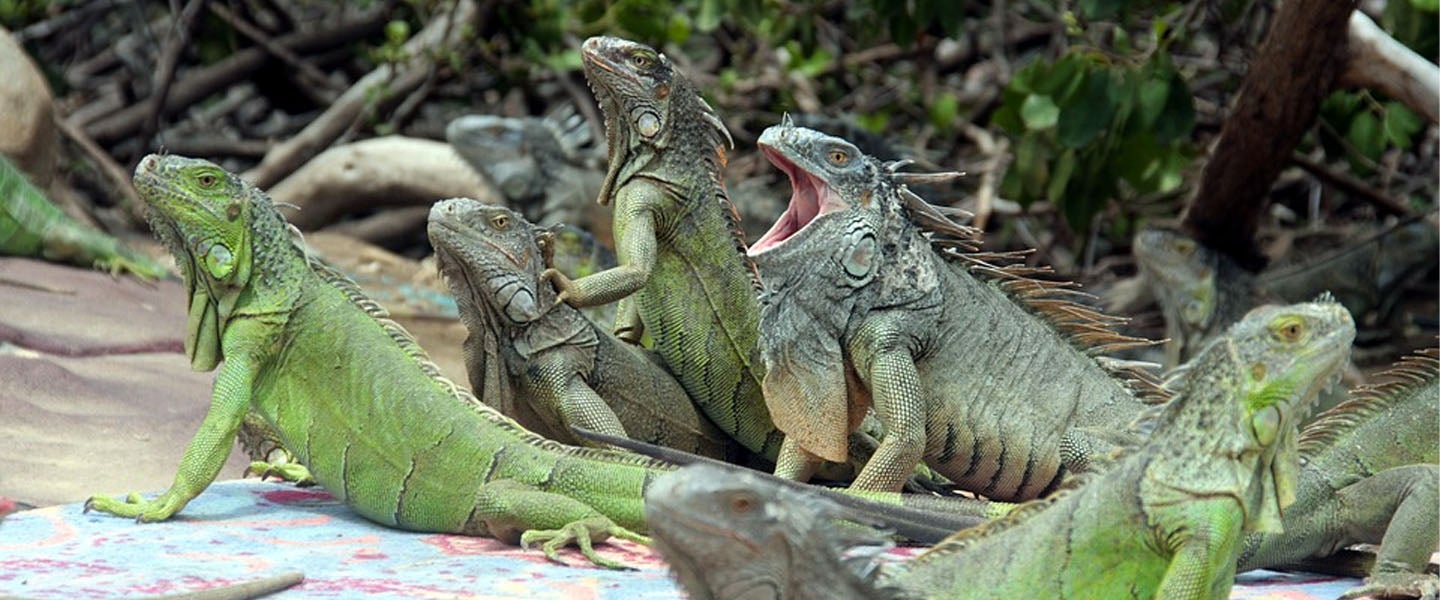Florida exists partly in this world, partly in the realm of myth. A state built mostly on the disposable income of retirees and drug dealers, its liberal public record laws ensure that the rest of the country is consistently fed stories of Florida Man, getting arrested for “aggressive wet willies” or masturbating in the Social Security office. But there truly is something chaotic about Florida, and having lived there for four years, I’m pretty sure the heat is largely responsible — not only does the temperature drive people crazy, but it allows massive, invasive, public property-destroying green iguanas to thrive.
The iguana problem is now bad enough that the Florida Wildlife Commission has removed restrictions against killing the reptiles, meaning that for some serious ecological protectors, and more likely, gun-happy Miamians, iguanas are to be bashed or shot on sight. Even for Florida, this is pretty damn weird, so how did we get here?
Invasive species have been a problem in the state since the 1960s, when South Florida’s growing population meant more zoos and pets. Thanks to a potent combination of human error, laziness and destructive hurricanes, tropical animals not native to the region, like the Burmese python and the green iguana, were repeatedly let loose or escaped into the wild, where they thrived. But only recently has the iguana population reached epidemic levels. As Richard Engeman, a biologist for the National Wildlife Research Center, told the South Florida Sun-Sentinel, cold snaps have previously prevented the iguana population from booming. The problem is, what with all that pesky climate change the average Florida politician doesn’t believe in, South Florida hasn’t experienced one in a decade.
It also doesn’t help that the residential neighborhoods of Miami are ideal for the iguana. With no natural predators and an extensive human-made canal system, iguanas have been free to eat and roam at their leisure. The problem for locals is that iguanas like to dig, and the canals aren’t enough for them — and so, they want to dig tunnels of their own. Sometimes, this means eroding sidewalks, seawalls and concrete home foundations.
They also love to shit everywhere.
Because of the damage to infrastructure and the threat to native species, as I mentioned earlier, the Florida Wildlife Commission (FWC) issued a statement in July that people are free to kill them on their property, or on FWC-managed lands (and as much as they please). “Green iguanas are not protected in Florida except by anti-cruelty laws and can be humanely killed on private property year-round with landowner permission. The FWC encourages removal of green iguanas from private properties by landowners,” the website reads.
Unfortunately for the now wanted-dead-only iguanas, there is one major difference between them and the giant, alligator-swallowing Burmese pythons that have plagued the state for decades: While the latter are a challenge to find, requiring skill and patience to hunt and kill in the wild, green iguanas are hanging out right in people’s backyards. Nobody knows exactly how big the iguana population is, but there have been reports of people finding 20 to 30 in their backyard at a time.
“Iguanas are really lazy, like one of the laziest reptiles,” says Olivia Forero, an employee of the Everglades National Park. “They don’t come into the parks much because they have to compete with other organisms for resources and would have to swim long distances. A few have been removed, but iguanas are more of an example of ‘urban wildlife.’”
“They’re disgusting little beautiful beasts,” says Max Eisenberg, a 26-year-old who lives in Miami and frequently finds iguanas in his backyard. “They make you feel like you’re in a tropical paradise, but then you realize how much of a threat they pose to native flora and fauna and that beauty kind of dissolves.” This, too, is a real issue: Beyond destroying public and private property, iguanas also have a tendency to eat up the plants that native creatures depend on. Per the FWC site, curbing the iguana population is a means of protecting endangered snail and butterfly populations in particular, both of which are integral to Florida’s entire ecosystem. Not to mention, iguana feces can transmit Salmonella to humans through water.
Nevertheless, Eisenberg isn’t too bothered by the iguanas — his bigger enemy is the peacock. “A flock of five of them shit all over my front porch and ate all of my mom’s iris flowers. I chase them away, but they’ve gotten confident and don’t run. I don’t want to kill one for fun like a sociopath, but I’ve come close and if it happens, I’m not going to be happy, but I won’t be too upset either.”
Though it’s not open season on peacocks yet, plenty of people have taken up killing iguanas for sport and profit. Men like Rodney Irwin, for example, a self-identified Iguana Expert and fourth-generation Floridian who can be hired to humanely kill iguanas. “This is something I feel strongly about. It needs to be done, and done now,” his website reads. (By his estimate, 50,000 iguanas need to be killed in order to restore the natural order.) Some others volunteer to kill iguanas, donating or selling the iguana meat online.
As for how the hapless beasts should ideally be exterminated, experts recommend bashing in iguanas’ skulls, or using a bolt gun similar to those used in slaughterhouses. But remember, it’s still illegal to torture iguanas or kill them in an inhumane way, which includes poison. You wouldn’t want to use poison anyway because, apparently, iguanas are pretty tasty –– a fact that’s earned them the truly brilliant nickname, “chicken of the trees.”
All in all, for once, maybe we shouldn’t place the blame on Florida Man for the state’s unique brand of weirdness. Because this is a place where a wheelbarrow of dead iguanas isn’t simply permissible — it’s encouraged.

